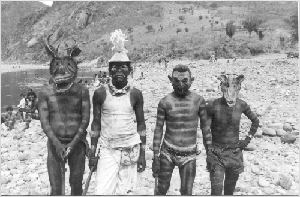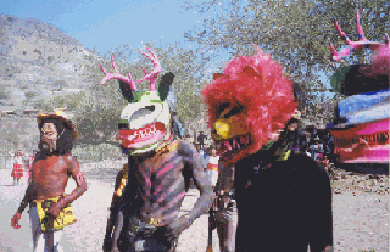
| Home | Itinerary | The Cora |
| Travel Information | Prices and Schedules | Photo Gallery |
Cora Religious Festivals
Virgen del Rosario
(October 5-8)
The goddess Tatei (Our Mother), who represents the earth and fertility, is one of the most important deities in the Cora pantheon. Some of her other roles are the goddess of the moon, and especially as the goddess of maize. After the Spanish conquest the identity of Tatei was merged with the Virgin of the Rosary, and today this saint is the patron of the town of Chuisete. Coras from all over the Sierra gather here to make offerings to her and to request special favors such as protection from illness, abundant children, and cattle and corn wealth. Coming at the the end of the rainy season, this is a harvest festival, and along with church-based festivities are many pre-hispanic rituals.
Día de los Muertos
(November 1-2)The Day of the Dead is celebrated all over Mexico, but among the Cora the fiesta takes on a special significance, combining some of the most important aspects of traditional cosmology and political organization. After the end of the rainy season the people bid farewell to the ancestor gods who brought the rains, as they return to their dry season homes in the east. People also carry offerings to their more immediate ancestors in the cemeteries, and also to the cliffside caves where the dead were formerly buried. These ceremonies take place largely at night and involve much owl symbolism. On November 2nd the Cora elders elect the community authorities for the coming year, after which a celebration is held.
The Virgin of Guadalupe is the principal religious figure of Mexico. Originally created by the Spanish in order to influence the Indians to convert to Christianity, the brown-skinned María ended up taking on the identity of Tonantzin, the Aztec earth goddess. This is one of the few fiestas celebrated by both Coras and mestizos (non-Indian Mexicans). Among the Cora she is an earth and underworld deity, and among the mestizos she represents goodness and purity, but for all she is a powerful and magic figures who receives many offerings.
Cambio de Varas
(January 5-7)In early January the Tahtuan (traditional governor) and other elected officials of each Cora community hand over their duties to the next generation of leaders in a ceremony of great pomp and pageantry. This rite, which is one of the most imortant of the year, is called el cambio de varas (changing of the batons) for the wooden staffs that symbolize the authority of each official. In the ceremonial center of Yauhke, this ceremony includes rituals in honor of the Tayau Nayeri, the small wooden figure who represents the ancient chief of the Cora.
Las Pachitas
(February)The fiesta of Las Pachitas is a period of licentiousness and merry-making before the fasting and austerity that precede Semana Santa. The main participants are young boys and girls who are permitted by their parents to stay out late. Each night they go from house to house, dancing around a brightly colored flagpole as a group of elders sing songs in a mixture of Nahuatl (Aztec) and Spanish. They are accompanied by a young girl who represents the earth goddess. According to the Cora, this group is searching for Jesus Christ, who is himself travelling about the world, but who is not found until Easter.
Holy Week is the largest and most important festival of the year. The Cora put on a very colorful and original version of this ritual, which has been featured in National Geographic and other publications. In the Cora pantheon, Christ corresponds with Tayau (Our Father), who is the sun god. For the Cora, the Christian Passion of Christ becomes the pagan sacrifice of the sun, to make way for the coming rainy season. The main attraction is the band of Judios (Jews). They are an unruly group of several hundred brightly masked and painted youths who represent demons, and who finally capture and sacrifice the Christ-sun. They take over the town for three days, dancing and running about in a series of well-choreographed rituals, including sexual initiation rites.
Mitote
The mitote is an ancient ceremony dedicated to maize, the rains, and the ancestors. These rituals, which contain no Christian elements, are performed by communities as well as individual family groups. They take place mostly at night, during which a shaman plays a bow drum and sings mythic songs as participants dance around a fire, stamping their feet to summon the ancestors. Because mitotes are not held on fixed dates, no trips are scheduled around them. However, there is a good chance that we can see one during the fall trips (October and November) and during the Cambio de Varas trip in January.

| Home | Itinerary | The Cora |